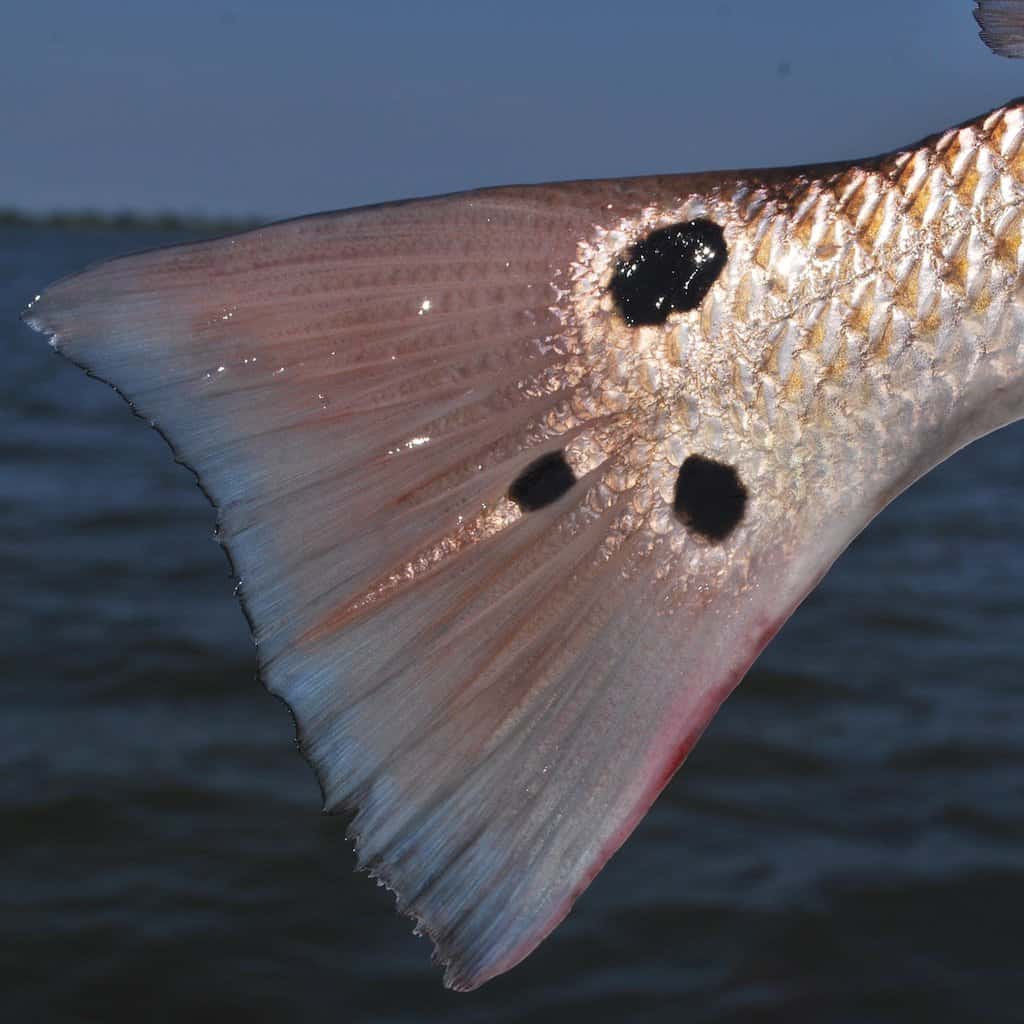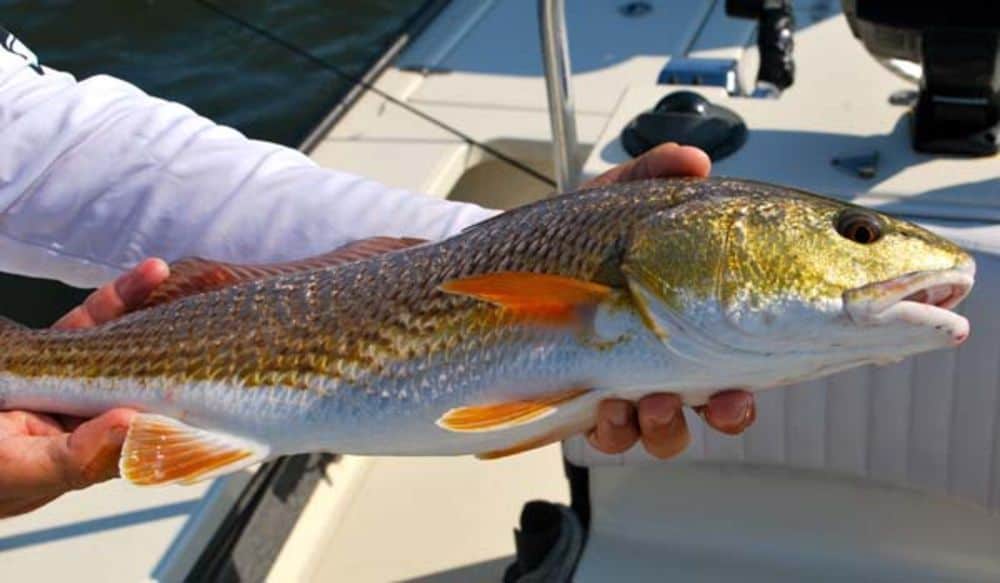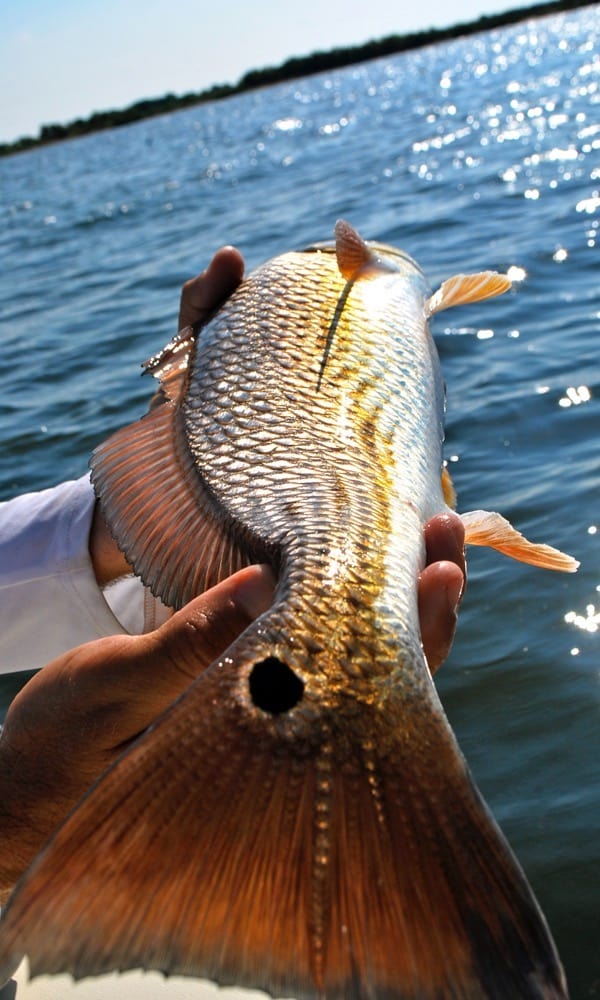Florida has more redfish than it knows what to do with. From the Panhandle to the Keys, redfish are waiting for you to catch them.
Especially in a state like Florida, with an outrageous amount of shoreline, finding the best redfish spots on your own could take a lifetime. We’ve put together this list to help you narrow the search.
Redfish (a.k.a. red drum) are everywhere, from the grass beds in Destin to shoals in Tampa Bay. We’ve grouped this guide into broad regions across the state so you can find big reds closer to your home or vacation destination.
One of the most entertaining fish to catch on lighter tackle, these saltwater beasts can break the 50-pound mark.
Considered by many to be the ultimate inshore gamefish, redfish fight harder, longer, and more brilliantly than almost any other inshore fish.
There’s something about casting a lure or tossing a fly into the seagrass and having a monster red hit. We almost guarantee the hair on your arms will stand at attention. Every fiber of your being will focus on the fight.
We want to get you right to the best spots, but we’ll mention that if you stick around to the bottom of this article, we’ll hook you up with all the how-to information you’ll need to catch redfish.
The Best Redfish Fishing in Florida
Florida has such a wide variety of sport fish that targeting just one can seem daunting. However, redfish are a perfect choice. They are widely available, fight like an angry bear, and are catchable by pros and beginners.
Redfish are ready to be caught year-round from Pensacola Beach in the northwest to the Keys in the south, but check out these hot spots.
Florida Panhandle Redfish Fishing
Several bays and beaches along the Panhandle to the Big Bend offer excellent action for redfish.
Pensacola Beach and Bay
Pensacola Beach offers everything an angler needs for redfish. The fishing pier on the beach is 1,470 feet long and stretches over two sand bars that hold reds.
The best time here is in the fall. Big bull reds head out of the bays and line up in the surf to spawn.
The pier can get crowded on weekends. Start your search for redfish about 1/3 of the way out on the pier.
Several public boat launches are scattered around the area, from Pensacola to Gulf Breeze, and Pensacola Beach has free public launches and marinas. Bal Alex in Gulf Breeze is a great spot to launch in the East Bay area. While there, also try your luck catching sheepshead.
Pensacola and Escambia bays hold loads of juvenile reds. The state regulations require them to be between 18 and 27 inches to keep, so you should have no problem getting your two fish limit in the bays.
Plenty of rentals, resorts, and hotels are available throughout the area. In addition, bait shops are everywhere you need them, and the shopkeepers are generally friendly and helpful.
Just down the road is Navarre Beach Fishing Pier. It’s the longest pier in the Gulf and has great access to redfish. It’s worth the visit!
Destin
Destin is an angler’s paradise. Awesome beaches, incredible scenery, and some of the best redfish angling in the state.
There are plenty of jetties around the bays. Redfish love the rocky and grassy shorelines along them.
Launch your boat at either Florida Park Boat Ramp near Elgin AFB or the boat ramp in Ross Marler Park. These free launches will get you close to the best spots in a hurry.
The best spots here are the Choctawhatchee River, Hogtown Bayou, East Pass, and the Mid-Bay Bridge.
Look for redfish around the river mouth and marshy areas. The river has many rocky structures and several bridge pylons to target. If it’s too hot, the fish head deeper and won’t be up in the river system.
Mid-Bay is excellent due to the bridge pylons. There are a few flats thrown in there as well.
Redfish will often be in the same areas as the speckled trout in any of these areas. So if you catch a sea trout, search around for reds that are likely nearby.
East Pass is fantastic. It gets busy in the fall, and for a good reason. The jetties get you right out onto the deeper holes where reds are holding.
Big Bend
From Tallahassee, south through the bend, you’ll find tons of access points. Homosassa River, St. Martin’s River, Mason Creek, Eleven Prong and Pepperfish Keys all hold redfish year-round.
The Big Bend area is quiet and often overlooked. As a result, there’s less happening here than in other coastal regions, which means less pressure on the fish.
Much of the area is in wildlife preserves, so few resorts or hotels exist. Instead, plenty of rocky shorelines await those looking to get off the beaten path and explore.
Central Florida Redfish Fishing
Central Florida has some of the best redfish fishing spots in the nation. From Mosquito Lagoon to Fort Myers and Cape Coral, there are plenty of redfish hot spots throughout the Gulf side, and the Atlantic coastline has epic surf fishing for them.
East Central Florida is nicknamed the Redfish Capital of the World. Grass flats in the Indian River system provide year-round fishing at its finest.
Indian River
Indian River flows into the Atlantic and includes several bays and lagoons. There’s also the chance to see some amazing airshows here since Cape Canaveral is just across the way.
The river boasts some of the best grass flats anywhere in the country. Giant mangroves crowd the shorelines, and channels and canals line the area.
Launch your boat at Jones Ave. Boat Ramp, Parish Park, or Bairs Cove. Bairs Cove also has a great kayak launch.
Be aware that manatees are lazily swimming through the river. Several sections are wakeless due to the threat fast boats pose to manatees.
Deeper channels are the perfect answer to a hot summer day, while you should target the flats in cooler weather. Mornings and evenings on the flats can be epic.
While fishing the Indian River, head through one of the many canals to link up with Mosquito Lagoon on the north side.
Mosquito Lagoon
We’re just going to say it: Mosquito Lagoon is the top spot for redfish anywhere in Florida. It’s part of the Indian River Lagoon system on the Atlantic and offers anglers the chance to experience incredible grass-flat fishing.
Reds cruise Mosquito Lagoon’s flats year-round. Whether targeting them with a spinning rod or on the fly, this is the perfect spot for you.
Indian Mound Fish Camp has an excellent boat launch, facilities, and a tackle shop on the north side of Oak Hill. There are several ramps in the area, though most have limited parking.
The lagoon is 21 miles long, ranging from grass flats, mangroves, and islands in the north to crystal clear, deeper water to the south.
Mosquito Lagoon has miles of perfect habitat for sight fishing for bull reds. Fish over 20 pounds are common, so if a trophy catch is your goal, this is an excellent place for it.
There are plenty of places to stay nearby, along with numerous guide services to get you on the fish.
Mosquito Lagoon truly is an angler’s paradise and also ranks among the best places in Florida to catch big tarpon.
New Smyrna Beach
Just to the north, New Smyrna is the place to go for giant bull redfish. The fishing here is only surpassed by the scenic beauty and ample wildlife.
The beach has several boat launches into the Atlantic or the Indian River lagoons. The Indian River starts at Ponce Inlet and runs south for 125+ miles.
River Deck Marina is a prime location for launching your boat, while Callalisa Park has plenty of kayak launches.
The area is full of channels and deep creeks cutting through the thick mangrove cover. Several mangrove islands litter the area.
Oyster bars, grass flats, bridge pilings, and jetties offer perfect conditions for redfish cruising the area.
Spend your time in the area just west of the Ponce Inlet and fish the far northern end of Mosquito Lagoon. The beachfront can also be productive, fishing off the sand shoals scattered along its length.
New Smyrna Beach is also known for sharks in shallow water, which can provide amazing sport fishing. We included this spot among our best shark fishing destinations in Florida.
Clearwater
Crossing over to the west side of the state, Clearwater is just northwest of Tampa Bay.
This spot nearly rivals the Mosquito Lagoon because the entire Clearwater area teems with redfish.
Launch your boat at Clearwater Beach Public Boat Ramp. The parking is cheap, and the concrete ramps are well-maintained.
Belleair Causeway Boat Ramp is another excellent spot. It will get you onto the intercoastal waterway.
Look for the ample mangrove shorelines and hit them with live mullet or shrimp once the tide starts going out. The movement will pull the reds out of the trees and into your waiting bait.
Grass flats dot the area, only broken up by fantastic channels and oyster shoals. All of these should be on your list for potential redfish-holding areas.
Plenty of opportunities exist here for the shore angler. You’ll find grass flats within casting range of the shore and sand shoals along the beach that provide perfect lanes for feeding redfish.
Charters in the area will put you on the fish. If you have little time to dial in the redfish fishing on your own, it may be worth the cost to book an expert.
Tampa Bay
Tampa Bay offers excellent fishing for reds, with the high season from March through October.
Grass flats, mangrove shorelines, and amazing oyster beds covered in fish fill this huge bay.
Launch at Causeway Boat Ramp on the northeast end of the bay or Maximo Boat Ramp in St. Petersburg. These locations offer plenty of parking, and Maximo is free at last check.
Structures spread throughout the deeper waters of the bay make for fantastic fishing, while the shorelines can be spectacular just after high tide.
The mangroves fill with water on a high tide, allowing the reds to move into them. When fishing here, wait until slack tide. Then, the reds start running back into the bay, providing some of the best action you’ll find.
Winter fishing is slower, though still absolutely worthwhile.
Tampa offers everything you’ll need for lodging and food. Tackle is readily available, as are several charters.
Tarpon Springs
Just north of Tampa Bay, Tarpon Springs is a great little area for redfish. Try this destination in the spring and fall for the best fishing.
Anclote River Park Boat Ramp and Mar Marina are great spots to hit the water.
Reds cruise the shallows clobbering the massive schools of pilchards. The small baitfish school up in enormous numbers. People have found pilchard schools over an acre in size.
Use pilchards as your go-to bait here.
While the fishing may be slower in the summer, spring and fall make up for it. Giant bull reds come in from the depths to feed like crazy on the pilchards before turning tail and heading south for the winter.
Apollo Beach
Apollo Beach has several great flats and mangroves on the east side of Tampa Bay. It’s easy to get to, just south of Tampa, and perfect for shoreline fishing.
There are plenty of boat launches in the area as well. Apollo Beach Marina is an easy-to-use, centrally located launch with plenty of parking.
Reds cruise the shorelines throughout the beach and are very active from spring through fall. Winter is a bit slower, though you can still catch some redfish.
The same tactics used around Tampa Bay work in the mangroves. Fish after the high tide and catch them coming back into deeper water.
Fort Myers
The islands around Fort Myers are covered in mangroves, channels, and grass flats. The fishing can be epic, with the chance of multiple 20+ pound fish in a single day.
Landings Marina is a great local spot to launch your boat. They are full-service and have a resident dolphin pod that hangs around most days.
Cape Coral, Captiva Island, and nearby Sanibel and Pine islands are fantastic, with unique features found around each of them. These islands also harbor some of Florida’s top snook fishing grounds.
The mangroves around the islands are super dense, allowing all sorts of prize fish the chance to cruise through them. Several bucket list species are possible here.
The scenery alone makes this a must-see destination.
South Florida
Southern Florida has excellent spots for reds. Miami, the Keys, and the Everglades are all worth a visit if you have redfish fishing on your itinerary.
Miami Canals
Reds tend to migrate into the canals and rivers throughout Miami. There are plenty of spots around the city to stop and cast a line, and the payoff could be a tasty redfish for dinner.
You’ll find numerous smaller inlets, bays, and canals along the beach. All of these will have reds at times.
Search the section you’re targeting for mullet. If you can locate a school, there are almost certainly hungry reds nearby.
Remember, redfish focus on the bottom, and in low-water situations, you might spot their iconic spotted tails sticking above the surface as they forage on shallow bottoms. Perfect time for sight casting.
Many Miami Airport Lakes have redfish in outstanding numbers, at least at times. The lakes have lock systems that allow reds, snook, and the occasional tarpon, to head inland. They get stuck in the lake when the lock closes.
Florida Keys/Everglades
Redfish can be abundant from the Everglades to the Keys. Plenty of deeper channels, creeks, canals, and tons of brackish water provide the perfect habitat for reds.
October tends to be the hottest fishing, but it stays excellent throughout winter and spring.
Flamingo Marina is a great spot to launch at the southwest corner of the Everglades.
Blimp Road Boat Launch in the Keys is perfect for launching a smaller boat or kayak and has a blimp floating overhead to help you find your way home.
Rock piles around the Keys provide the perfect opportunity for some monster reds. The summertime heat tends to send the reds into deeper water, so it can be tricky to locate them. Fall through spring is the best time.
Be sure to check out our complete guide to fishing in Florida’s Everglades.
How to Catch Florida Redfish
Now that you know where to catch redfish in the Sunshine State take a moment to learn how to catch one of the best near-shore gamefish you’ll find anywhere.
Gear, Tactics, and Tides
Bait and Tackle
Gear doesn’t need to be overly complicated. Redfish are so popular in part because they’re easy to catch.
A medium-heavy rod between 7 to 10 feet in length should handle everything redfish throw at you. For line, 20- to 30-pound test braid will handle them.
Redfish eat mullet, shellfish, crabs, pilchards, and just about anything else easy to chase down.
Spring and early summer are perfect for tossing cut mullet on a 5/0 to 7/0 hook.
Live baits are fantastic options and tend to be the most productive. Live shrimp, mud minnows, mullet, croaker, and pinfish all work well.
Fish live mullet and pinfish over deeper spots and drop-offs, while minnows and shrimp work great over the mud flats and grass beds.
Use shrimp and crab imitation plastics, mullet-shaped plugs, and for some epic strikes, poppers.
Summer and fall find redfish hitting shrimp, crabs, and mullet.
Bull reds are always hungry and tend to go after nearly anything if fished properly.
Redfish Tactics
While a boat is nice, you can catch redfish right from the beach. They cruise along the breaks looking for mullet. Toss a popping cork mullet imitation, and you’ll have good chances.
Reds range from 2 feet deep to around 35 feet. If you’re offshore, target depths of 30 feet and troll for them. Keep your eye out for blowups on the surface. If birds are congregating, get there and toss a mullet.
Sight casting requires putting the bait around 10 feet in front of moving fish. Reds tend to look down for their meals, so casting well in front of them allows the bait to sink into the strike zone.
Shrimp and mullet make great bait because they get down into the range quickly, and reds have an incredible sense of smell. They have four nostrils!
Tides
High tides send redfish into shallower flats. Low tide sends them out into deeper water near drop-offs. The period after a high tide is prime for targeting mangroves. Tidal water movement is the best time to fish, particularly after high tide.
High tide shallow fishing can be epic. Toss a blue crab or imitation and hold on tight.
Catch More Redfish
If you’re determined to catch a big red or two, check out our full guide to redfish fishing, written by one of our contributors who grew up fishing along the Gulf of Mexico.



